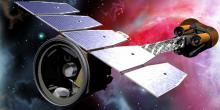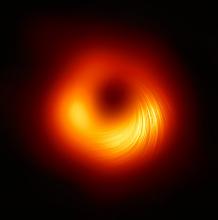Listen to today's episode of StarDate on the web the same day it airs in high-quality streaming audio without any extra ads or announcements. Choose a $8 one-month pass, or listen every day for a year for just $30.
You are here
Moon and Saturn
Just days before its demise, the Cassini spacecraft recorded an odd chorus: radio waves produced by particles from the moon Enceladus that were zipping through Saturn’s magnetic field. Saturn’s magnetic field is strong but weird. It’s produced by the motions of different layers within the planet itself. These motions generate electric currents, which in turn create the magnetic field.
That’s pretty standard. In fact, it’s how Earth generates its magnetic field.
The weird thing about Saturn, though, is that its magnetic and geographic poles are almost perfectly aligned. Scientists had thought that to produce a magnetic field at all, the magnetic poles had to be tilted. Yet Saturn’s magnetic field is stronger than that of any other planet except Jupiter.
The magnetic field traps charged particles from the Sun and other sources, including Enceladus. The charged particles form radiation belts around Saturn.
The magnetic field funnels some particles toward Saturn’s poles, where they produce aurorae — like the northern and southern lights here on Earth. Cassini recorded their radio waves as well — the chorus of a giant planet’s giant magnetic field.
Saturn is in great view late tonight. It looks like a fairly bright star close to the Moon as they climb into sight in the wee hours of the morning.
Script by Damond Benningfield






